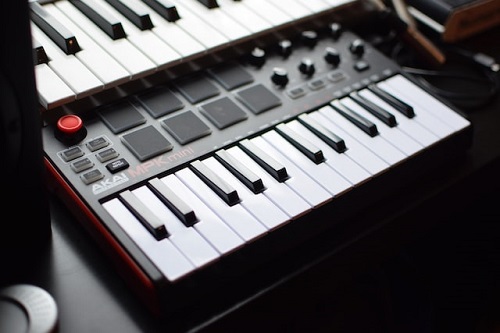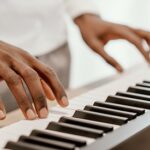Pianos come in a variety of types, each with its own specifications. One such specification is the number of keys. Depending on the type of piano, there could be as few as 36 keys or as many as 88 keys. The number of keys on a piano affects the range of notes that can be played, as well as the size and weight of the instrument.
In this article, we will further discuss the number of keys in pianos, particularly electric keyboards. Electric keyboards often have more keys than traditional pianos, which can give musicians more flexibility when playing. However, some keyboard players prefer the smaller size of a traditional piano. Ultimately, it is up to the musician to decide which type of piano they prefer.
Acoustic Pianos
The average modern acoustic piano has 88 keys that span a range of 7 and a quarter octaves. This is an impressive range that provides the player with a wide variety of notes to choose from. This particular span of 88 keys on a piano is equivalent to 7 octaves plus 3 extra keys that are added to the bass notes.
However, it wasn't always standard to have 88 keys on a piano. The first widespread 88-key piano was built by Johann Andreas Stein in Augsburg, Germany in 1783. Before that, most pianos only had about 60 keys.
Some more recent acoustic pianos do not follow this traditional standard. An example of this is Bösendorfer's 97-key piano. This piano has an extended range, which allows for a greater variety of dynamics and expressive possibilities. Meanwhile, the Australian company Stuart and Sons have created a 108-key piano that spans 9 octaves. This is the widest range of any commercial piano currently available on the market, providing pianists with a wider range of notes to choose from.
Digital Pianos
The digital piano is a type of electronic keyboard designed to serve as a replacement for the traditional acoustic piano. Digital pianos typically use advanced sampling technology to faithfully reproduce the sound of an acoustic piano, and they often include features designed to emulate the playing experience of an acoustic piano, such as weighted or semi-weighted keys and touch-sensitive controls.
The digital piano is designed to replicate the sound and feel of an acoustic piano. As such, it usually has the same number of keys as an acoustic piano. This allows for a greater range of notes and tones, making the digital piano a versatile instrument. The number of keys on a digital piano can vary from as few as 25 keys (mini keyboard) to 88 keys (full-size grand piano keyboard).
Although digital pianos and acoustic pianos might look the same, they don't have the same key range. The key range is the number of keys on a piano. Acoustic pianos have 88 keys, but digital pianos can have fewer or more, depending on the make and model.
You will often find that manufacturers produce digital pianos with 76 keys in addition to those with 88 keys. The extra 12 keys found on 88-key digital pianos can come in handy for advanced piano pieces and offer a more realistic feel and sound. A standard piano has 88 keys, but a 76-key piano omits the eight keys farthest to the left and right. This leaves a 6 1/4 octave span on a 76-key piano, which is still plenty of room to play most pieces of music.
Electric Pianos
Electric pianos are, in many ways, similar to electric guitars. Both instruments use electricity to create their sound, and both can be plugged into amplifiers to make the sound louder. However, there are also some important differences between the two. Acoustic pianos have been around for centuries, while electric pianos were invented much more recently. Acoustic pianos usually have 88 keys, while electric pianos often have far fewer. Electric pianos typically make a brighter, sharper sound than acoustic pianos.
Electric pianos have been used since the late 1920s, though they've only gained popularity in recent decades. Despite their name, electric pianos don't use strings like acoustic pianos - instead, they use either tines or reeds to create sound. The most popular electric pianos are the Fender Rhodes (which uses tines) and the Wurlitzer Electronic Piano (which uses reeds).
Also, there are many electric pianos on the market from manufacturers such as Baldwin, Kawai and Yamaha. These pianos often resemble traditional grand or upright pianos, with the addition of pickups to amplify the sound. Most electric pianos feature 88 keys, just like a standard piano.
Electronic Keyboards
While digital pianos are designed to closely imitate the look, feel, and sound of an acoustic piano, electronic keyboards were created for a different purpose entirely. Keyboards typically have more features than a digital piano, such as the ability to create and edit sounds, layer multiple sounds together, and connect to other devices and computers.
Most electronic keyboards come with a huge range of pre- programmed sounds, such as different types of pianos, various orchestra instruments, and lots of different synth patches. This means that you can easily switch between different sounds without having to fiddle around with any settings. This variety of sounds can be extremely helpful for keyboard players who want to expand their sonic palette, or who simply enjoy having a lot of options to choose from.
Electronic keyboards are not designed to perfectly imitate either digital or acoustic pianos. They serve different purposes and, as a result, have different features. For example, electronic keyboard keys may not have the same range or feel as those on a piano.
There are two popular sizes of electronic keyboard: 76-keys and 61-keys. Most manufacturers make and sell keyboards in both of these size ranges. The76-key keyboard is the larger of the two sizes. It typically offers a wider selection of features than the 61-key model, making it a better choice for more experienced players.
A 61-key instrument falls significantly short when compared to an 88-key instrument. The latter provides a much fuller range of notes, allowing for a richer, more complete sound. As a result, 88-key instruments are generally considered to be superior to their smaller counterparts.
Should You Get 61-Key, 76-Key, Or 88-Keys?
The number of keys on an acoustic piano, digital piano, or electronic keyboard can be overwhelming when purchasing one. There are 88 keys on a standard piano- from the lowest bass C to the highest treble C. This may seem like a lot to learn at first, but remember that each octave (group of 8 notes) repeats itself. You will only need to learn the notes in one octave before moving on to the next. The number of keys does not necessarily dictate the quality of the piano; it is important to choose a piano that is comfortable for you to play.
If you're just starting out, a 61-key keyboard could be a good choice for you. It can help to break things down and make it more manageable when you're first starting to learn. Plus, having fewer keys can also make it easier to navigate and find the notes you're looking for.
On the other hand, the 76-key keyboard is perfect for intermediate users who want to improve their skills. The extra keys allow for more complex patterns and chords, making it the ideal choice for those who are serious about taking their playing to the next level.
Lastly, the 88 key keyboard is the most versatile and therefore the most suitable for advanced players. Genres that require a range of both lower and higher notes benefit from having 88 keys available.
Pianos come in a variety of price ranges, from digital to acoustic. Many people opt to invest in a higher-end instrument as they advance in learning the piano. This is because higher-end instruments tend to have more features and better sound quality than lower-priced options. Additionally, investing in a higher-quality piano now may save you money in the long run, as you will not need to upgrade to a better model as your skills improve.
Harlan Kilstein began playing piano during covid with no piano background at all. He taught himself how to play learning what to do and what not to do.
Today he's an advanced intermediate player and can help you grow in your skills because he learned all this on his own.








